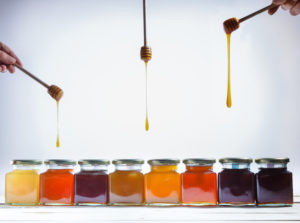A Honey Boo Boo? The Ninth Circuit Discusses Bees, the “Reasonable Consumer,” and the Intersection of Federal Labeling Law and Section 75-1.1
Imagine yourself combing the aisles of the local Trader Joe’s with your brood in tow. You are minding your own beeswax when, above the drone of swarming shoppers, you hear a buzz about a new product: “100% New Zealand Manuka Honey.” As you grab a jar off the shelf, what would you reasonably believe was inside?
The United States Court of Appeals for the Ninth Circuit examined this question recently and offered some lessons about litigating section 75-1.1 claims in the process.
The Comb Foundation
Moore v. Trader Joe’s Co. was a putative class action brought under the consumer-protection laws of California, New York, and North Carolina. The plaintiffs purchased a Trader Joe’s store brand of “100% New Zealand Manuka Honey” that listed “Manuka Honey” as its sole ingredient. Disappointed to learn that only 57.3% to 62.6% of the honey inside actually derived from Manuka flower nectar, the plaintiffs sued. They claimed that the product was adulterated because it had been made, in part, with the nectar of other types of flowers. They also claimed that Trader Joe’s label was misleading because it implied that the honey inside was derived exclusively from the nectar of Manuka flowers.
Carolina. The plaintiffs purchased a Trader Joe’s store brand of “100% New Zealand Manuka Honey” that listed “Manuka Honey” as its sole ingredient. Disappointed to learn that only 57.3% to 62.6% of the honey inside actually derived from Manuka flower nectar, the plaintiffs sued. They claimed that the product was adulterated because it had been made, in part, with the nectar of other types of flowers. They also claimed that Trader Joe’s label was misleading because it implied that the honey inside was derived exclusively from the nectar of Manuka flowers.
Trader Joe’s moved to dismiss the complaint on two grounds: (1) that the label was not misleading and the product was not adulterated as a matter of law, and (2) that the state-law claims were preempted by federal labeling laws. The trial court agreed with Trader Joe’s on both points and dismissed the case. The plaintiffs appealed.
Let Me Tell You About the Birds and the Bees
The Ninth Circuit began with some basic facts of life about honey—some of which you probably knew, but others that you may not have.
Honey is made by bees. Bees forage among flowers to collect nectar for honey. By examining a honey’s pollen content, you can estimate the relative concentrations of different floral nectars.
The FDA provides guidance on how honey may be labeled for sale. Although all honeys are made from a combination of different floral nectars, these are not considered separate ingredients. For labeling purposes, honey is a “single-ingredient food.” The FDA allows a honey producer to label honey as being derived from a particular plant or blossom (e.g., clover honey, tupelo honey, or orange blossom honey) if it can show that the plant or blossom on the label is the “chief floral source of the honey.”
The Manuka bush is a plant native to Australia and New Zealand. Honey derived from the Manuka’s floral nectar contains methylglyoxal, an organic compound believed to have antibacterial and other beneficial properties. As Manuka honey has grown in popularity, producers have developed a system for grading the purity called the “Unique Manuka Factor” or “UMF” system. The UMF system grades a honey’s concentration of methylglyoxal on a scale of 5+ (at the low end) to 26+ (at the high end).
The “Reasonable Consumer” Is a Busy Bee
The Ninth Circuit affirmed the dismissal, reasoning that the plaintiffs’ claims failed as a matter of law.
The court made quick work of the adulteration claim. That claim rested exclusively on the fact that the bees had visited different flowers—not only Manuka blossoms. This was not adulteration, the court explained: “Bees make the honey, without any input from Trader Joe’s or any other manufacturer.”
As to the claim that Trader Joe’s label was misleading, however, the Ninth Circuit did something more unusual. Although reasonableness is almost always a question of fact that cannot be resolved on the pleadings, the Moore court held that it was unreasonable as a matter of law for a consumer to be misled by Trader Joe’s label. To reach that result, the court turned to the fabled “reasonable consumer.”
Under section 75-1.1 and the other state laws invoked, the Moore court explained, “claims based on deceptive or misleading marketing must demonstrate that a ‘reasonable consumer’ is likely to be misled by the representation.” For example, the Eastern District of North Carolina’s Solum v. CertainTeed case, to which Moore cited, held that “reasonableness” requires the recipient of the representation to use “reasonable care to ascertain the truth.”
The Ninth Circuit reasoned that “other information about Trader Joe’s Manuka Honey would quickly dissuade a reasonable consumer from the belief that Trader Joe’s Manuka Honey was derived from 100% Manuka flower nectar.”
What information should have tipped off the reasonable consumer? The Ninth Circuit identified three points:
- First, it is impossible to make honey that is 100% derived from one floral source. The court discussed the “foraging nature of bees” and charged the reasonable consumer with knowing that “it is impossible to exercise complete control over where bees forage down to each specific flower or plant” and that “[u]nlike other domesticated animals, bees cannot be commanded or directed.”
- Second, the comparatively low cost of Trader Joe’s product should have been a “signal” that the honey inside had a lower concentration of honey derived from Manuka flower nectar.
- Third, the Trader Joe’s label did include the product’s “10+” rating on the UMF scale. The court explained that “[r]easonable consumers of Manuka honey would routinely encounter such ratings and would likely have some knowledge about them.”
The Ninth Circuit similarly rejected the plaintiffs’ claim that Trader Joe’s label was misleading because it claimed a single ingredient: Manuka honey. The Moore court looked to the FDA guidelines for labeling honey. It concluded that Trader Joe’s single-ingredient label was appropriate under those guidelines. “Manuka honey,” it reasoned, meant “honey whose chief floral source is Manuka.” Even plaintiffs’ analysis that Trader Joe’s product was 57.3% to 62.6% pure confirmed that this was true.
Having concluded that the label was not misleading as a matter of law, the Ninth Circuit did not need to decide whether federal labeling laws preempted plaintiffs’ state-law claims.
Have Consumers Been Stung?
The Moore court charged the reasonable consumer with knowledge of several nuanced facts about bees, honey, and how Manuka honey is graded. Scholars are already debating whether this was fair. See, for example, Rebecca Tushnet’s thought-provoking post on the case.
After all, the rare cases that do hold that it is unreasonable as a matter of law for consumers to be misled tend to read like a page from Captain Obvious’s diary. The reasonable consumer is expected to know, for example, that
- there is no fruit in “Froot Loops”;
- Cap’n Crunch “Crunch Berries” are not actual berries;
- soymilk does not come from cows; and
- a cracker is a “dry thin crispy baked product” and is “not composed of primarily fresh vegetables.”
On the other hand, Manuka honey is a “niche, specialty product”—not a “low-cost, everyday item[]” like shelf-stable parmesan cheese. The Moore court seized on this fact to explain why a reasonable consumer of Manuka honey would be expected to exercise greater diligence, to have a keener price sensitivity, and to have known about the UMF grading system. In short, the Ninth Circuit expects the reasonable Manuka honey consumer to be a busy bee.
The Flight Path for Section 75-1.1 Litigants
Moore is a helpful data point for anyone litigating section 75-1.1 claims about deceptive or misleading advertising or labeling. It provides new insight into the mind of the elusive reasonable consumer.
Moore’s use of FDA guidelines and industry standards like the UMF grading system is notable, too. Although the Ninth Circuit never reached the question of whether federal labeling laws preempted section 75-1.1, its analysis relied on those laws and similar standards. As we have discussed in the past, courts evaluating section 75-1.1 claims frequently borrow conduct standards from external sources. Here, both the FDA guidelines and the industry’s UMF grading system informed the court’s analysis of Trader Joe’s conduct.
Do you find Moore’s reasoning sweet? Or did it leave you feeling stung? Either way, its lessons can inform your section 75-1.1 practice. And we hope we’ve left you a more educated consumer of honey heading into National Honey Month.
Author: Tom Segars


